Luggage is a frequent traveler’s most important tool. I had the chance to review the Away Carry-on and my experience was a mix of both what I expected in smart luggage and a few surprises.
If you are considering booking travel or signing up for a new credit card please click here. Both support LiveAndLetsFly.com.
If you haven’t followed us on Facebook or Instagram, add us today.
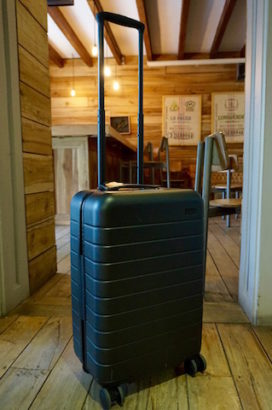
Background
While I am not on Ryan Bingham’s level yet, packing and moving through an airport quickly is a top priority:
and…
I primarily use a Rimowa Topas 28” or 31” stainless steel roll-aboard that it would be hard to live without. The quality is second to none, their service is excellent. While I have never had to use it, they will make a repair in your hotel just about wherever you are in the world by sending a local technician and airmailing the part.
While Away may not yet have technicians all over the world, they do guarantee their product with a lifetime warranty – spinner wheels, handle, whatever – they stand by their product and will fix it, no questions asked. In my experience, companies who agree to fix anything that breaks on their product free of charge tend to just make it better the first time, and I look for that in a brand. That speaks to their motto: First Class luggage at a Coach price.
As timeless as Rimowa suitcases are, they also have not caught up to some of the modern advancements that make other bags more appealing. Bags are now trackable, some come equipped with e-ink displays for bag tagging in the event you choose to check your luggage; there are hotspots, and charging ports, wheels that tilt, rotate, and even carry-ons you can ride like a tiny motorcycle through the airport. My Rimowa has none of that, and for short trips, I am more or less in the market for something with the latest bells and whistles.
Rimowa cases are also a substantial financial commitment running from as little as $400 to more than $1,000 per case for the Topas series (I purchased mine at an incredible discount). When looking at other luggage pieces, carry-ons can run from $20-300 depending on functionality and brand. If we conclude that Rimowa is an outlier and exclude them from the sample set, the Away bag comes in at the middle to high end of the price spectrum. For some readers that price point will be totally reasonable and for others, it is as much as they will spend on a weekend to a nearby city, so really this comes down to the importance you place on convenience, style and quality.
Away’s Product Line
Away offers three sizes: The Carry-on ($225), The Medium ($275), and The Large ($295). They all offer TSA-approved combination locks, a quality German polycarbonate shell (light and sturdy) and interior netting which is a bigger reason to buy than expected. Only The Carry-on offers charging capabilities for obvious reasons.
Away sent me a bag to try and I gave it a run for it’s money. What kind of run, you ask? Why, a mileage run of course. Here was the loose itinerary for this trip:
PIT-DEN-LAX-JFK//EWR-MIA-MDE, MDE-MIA-LGA//JFK-LAX-CLT-PIT
For those who may not recognize some of those airport codes:
Pittsburgh to Denver to Los Angeles to New York City, JFK (switch airports on land) Newark to Miami to Medellin. Returning Medellin to Miami to New York LaGuardia (switch airports) New York JFK to Los Angeles to Charlotte to Pittsburgh.
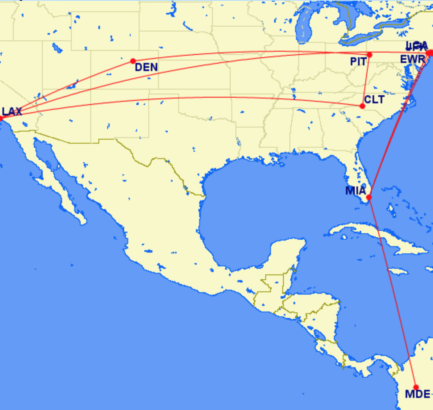
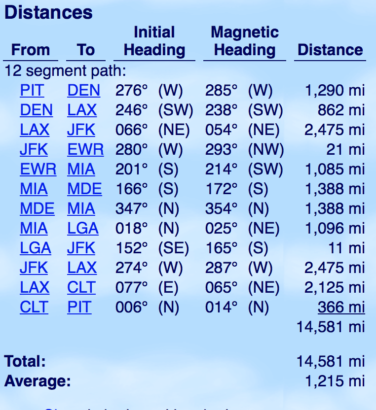
That’s a lot of wear and tear on yours truly and really gave the Away carry-on a solid introduction to the world I live in. It arrived in a clever box, wrapped in a white dust bag and had a charge still on the USB unit, though I charged it that night anyway. It came with its own micro USB connection to charge the internal battery, a power plug, two ports for USB charging of devices (one standard and one a supercharger), internal dirty laundry bag and some really helpful netting.

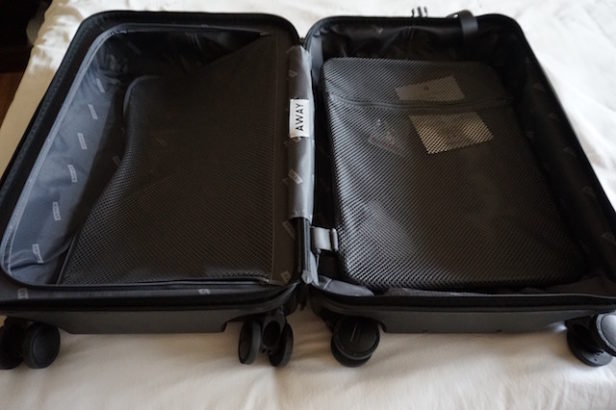
I was mid-trip when I picked up the suitcase in New York and the journey was several days so I needed to ensure that I could not only fit everything I had brought in my soft side duffel bag but also my work laptop – because it’s unnecessarily heavy – and the duffel itself. For good measure, I tossed in a few pairs of pants, some boots and switched to flip flops for the rest of my trip to test the full capacity of the bag and see if the zipper held up as well as my snaps on the Topas.
I didn’t need to utilize any packing cubes but I did appreciate the water-resistant laundry bag for dirty clothing. Even in Away’s bigger carry-on models (that still fit in the overhead bin) separation is key. This piece was also Away’s original carry on size when they launched in 2015 but they now offer several variants.
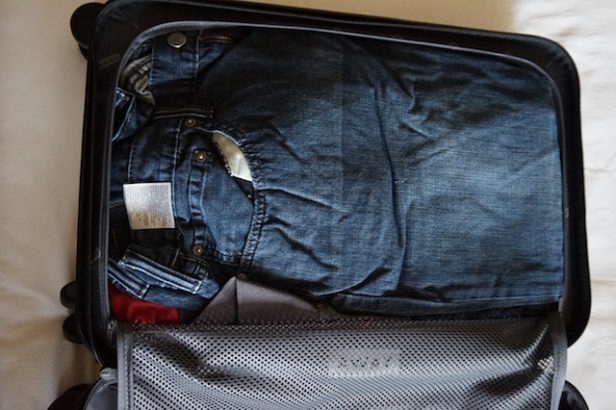
It surpassed my expectations. As a seasoned traveler (like many of you are), I live and die by my carry-on. I put a lot of pressure on the case and had to drop a knee on it to get it to close but despite my best efforts, the luggage zippers held up fine and had no issues when opening and closing later. This is the truest test I can really put on a case because this is the area I stress the most when I travel. For any trip of fewer than ten days by myself, I am not checking a bag but I still have a lot to pack and carry. I have nothing but good things to say about the performance of pressure packing Away’s Carry-on.
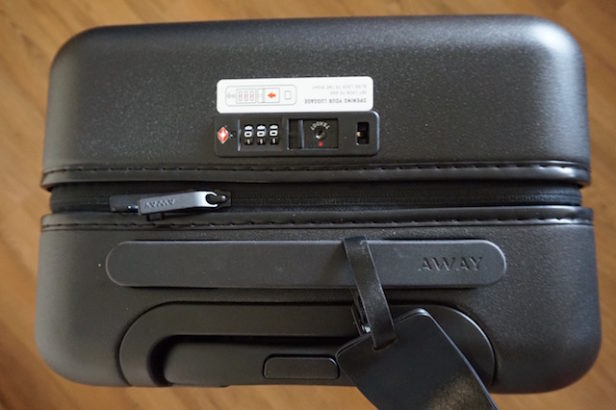
Weight/Capabilities
The weight of the Away Carry-on is a major plus for consumers as is the size. It is approved by most European carriers, even the discounters, who generally require that carry-on bags measure 22″ or less, while most US carriers allow at least 22″ up to 24″ in height. For American and Canadian readers that spend a lot of time on regional jets and do not want to gate-check their bag, a carry-on that conforms to European standards is ideal. For carry-on standard by airline I think that the Carry-on Guy has a great chart. The Away carry-on, void of my personal items is just 7.2lbs or just 3.25kg (measures 21.7″ x 13.7″ x 9″ and holds 38.0L). That allows me to put heavier items in the luggage without encroaching onerous airline limitations such as 50lbs checked, or in Europe, 7-10kg depending on the carrier. Wasting that weight before you have loaded in your first pair of socks on a heavier case or wheels is something I try to avoid.
Once it is packed and ready to go, I put my substantially heavier backpack on top of it holding onto the top handle of the carry-on and my backpack in the same grip. This is an important performance test as well because I have everything in my backpack. My personal MacBook Pro, cameras, chargers, USB cords, physical books, occasional imagines, journals, and iPad mini, a word phone, foreign currency, pens… it goes on a while, and I need to clean that thing out. It weighs between 30-50 lbs depending on how recently I have cleaned it out, and strapping that to my back is exhausting.
In short, any rolling carry-on needs to be able to support the weight easily without inhibiting my movement. This one missed the mark as it was ultra top heavy and the carry-on itself was only 22 lbs fully loaded. In this case, it was a drawback to use the lighter bag because it could not support my heavier backpack. It’s not the intended use and the manufacturer would rightly argue that they didn’t build the bag to hold my unreasonably heavy backpack on top of it, but in reality, this is how I travel and this is what is important to me. I am also sure that I am neither the first nor the last person to top my rolling carry-on with another bag, in this case, a heavier one.
Moving gently through airports was not a problem, but if I needed to pick up the pace, the lightness of the Away carry-on was an issue. It would tip or tilt and more than once, I threw the backpack over my shoulder as it wasn’t worth the struggle. Another durability question came in when I looked at the bag after returning home. There were scrapes and scratches on the case (almost certainly from the teeth of escalators at MIA) and the appearance after this single trip included some small markings at the base of the case and a couple elsewhere. Away informs me that the marks can typically be removed by a soft rag and warm water, I have not been able to apply this method and determine if the scratches were more permanent than they suggest. Rimowa cases are notoriously easy to scratch and dent so much so that they have developed this into their marketing plan. If scratches are part of the program, perhaps Away should consider a similar marketing angle.
“With time, every aluminum suitcase acquires a patina of its own. These are the scratches and dents that recall trips taken and make the RIMOWA suitcase unique.”
And users seem to embrace and enhance their patina:
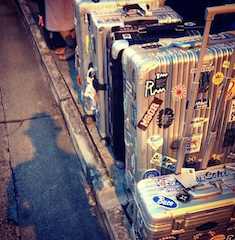
Looking at the lightness of the bag again, one other concern is that the telescopic handles didn’t feel sturdy enough for the trip. Matthew met me in LAX, I showed it to him as well and he shared my concerns. I didn’t have any direct issues, the handle locked in to place as it should while it was either raised or lowered into the case. But moving around with it, even without the backpack, the handles would twist left and right and felt like they could snap at any moment. This give could be well within the range of tolerance for the piece and if you do not load your bag full and heavy your experience might vary, but for me, I would trade the lightness of the case in favor of a heavier, stronger handle with less give.
Battery/Charging
The battery was a key feature of this case and the dual USB ports were a huge draw for me. I blow through battery when I am in an airport because my phone is often my boarding pass, I am texting with business partners and family before push back. One of the USB chargers is a standard charger, and the other is the supercharger. The night before I would fly, I plugged in the case to the wall and my phone or iPad into the standard port.
By morning, I had full batteries on both devices. While I was moving around, I plugged my phone into the supercharger and no matter how low the battery was or how long I charged it, it never dropped the battery of the case below 75% (three lights of an available four). And it really was a supercharger. I went from 10% to 80% in about 30 minutes while I walked through the airport. That’s worth a lot to me, and I thought the battery performed above expectations.
Updated versions feature an ejectable battery. This version of the case can be converted for free from away to make it a removable battery and TSA compliant.
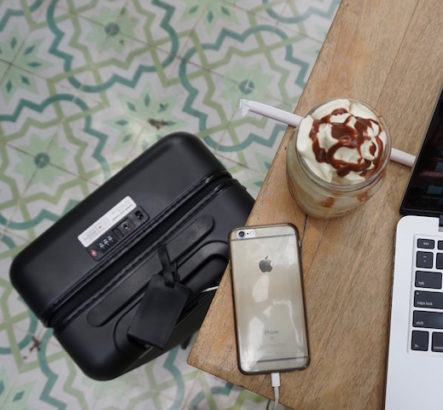
Obvious to some, but apparently not to me, the battery does take up space inside the interior of the bag, just as the telescopic handles do. The battery was substantially larger than I had anticipated, great for charging, bad for packing. The trade-off for me had lost some of its luster with the packing limitations. The sections provided by the telescopic handles are golden to me because I typically pack things that don’t matter if they are wrinkled (socks, underwear) outside of and between the handle shafts and create a flat surface to place my clothes. Because the cloth screen was on the unaffected side of the bag (completely flat) and I needed a place for odd sized items like my boots, the battery really got in the way. I would have traded half the performance of the battery for one half the size.
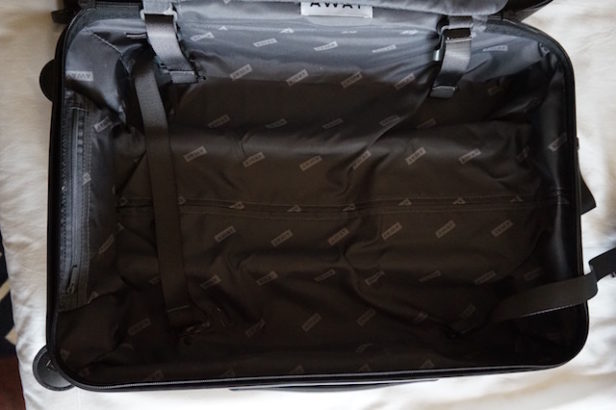
The wheels rolled fine inside the confines of the airport and on sidewalks. Traveling abroad I often encounter cobblestone streets, unfinished pavement, and gravel which was a challenge for this case. But even when I got home, walking to my vehicle in the parking lot seemed like more than the wheels were designed for with the uneven pavement. This is an important part of the journey. I don’t want to have to carry my carry-on ever (that sounds wrong but it’s so right). The longest 500’ of my trip was the exit from the airport through the parking lot to my vehicle. While I did not have an issue, I think I might in the future and that is of concern. When thinking about trips to Myanmar, Thailand, Brazil, Morocco, the wheels would have likely needed replacing after more than just a few trips. But for my test trip alone, they did perform on this difficult service (though not well) and the wheels did not break.
Would I Buy One?
My recommendation to readers and friends is a tough one. It really depends on your travel plans, budget and what is most important to you. The charger worked really well, the bag was incredibly light, it fits in more than it should have and the zippers performed flawlessly. It also struggled with added weight, it felt too light to be tough in the handle for my travel needs, and the battery took up a considerable amount of space. It does add some features than my Rimowa doesn’t but these are also two very different price categories. The case was well-made and seemed like it would hold up to normal travel demands for a domestic road warrior.
When comparing to other smart bag companies, BlueSmart, which was perhaps one of the first entrants into the space adds a carry-on scale and a locating feature so that you know where your bag is. However, it’s 30% heavier (9.4lbs), I rarely need to weigh my bag outside of the airport so the scale feature doesn’t really appeal to me, and the cost is two to three times the price ($449-$599). Away also offers a free trial for 100 days, if you don’t love it, just return it for a full refund. I don’t know of another manufacturer that offers not to just return and refund your money but actively promotes a 100-day trial. This matches the BlueSmart 100-day trial offer.
If you are in the market for a new carry-on and value a lightweight bag, the ability to charge multiple devices fast, and want something that is quality-made, the Away carry-on is a great fit at an excellent price.
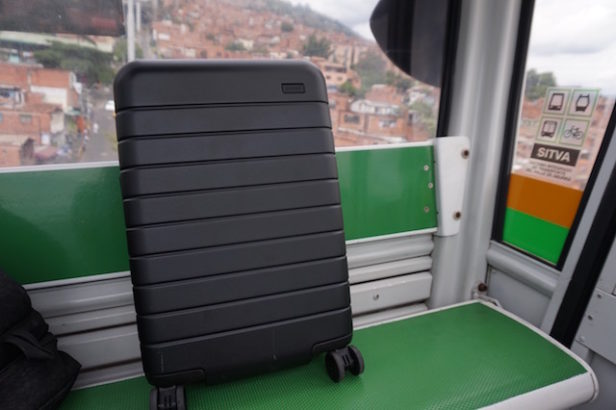
Read More:Away Travel Replaces Smart Luggage Batteries
Read More:Airlines Aren’t Killing Smart Luggage Manufacturers
Have you tried the Away Carry-on? Do you have another favorite smart bag you’d rather?

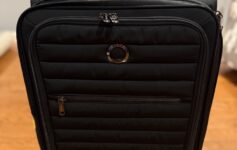
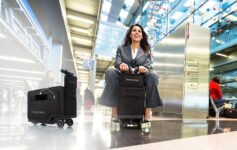
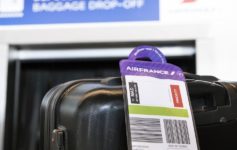
Dimensions?
@Babage: Sorry I left those out. They are posted now and available via any of the links to Away’s page. Thanks for reading.
Great + thorough review! This was incredibly helpful. I’ve been looking into different suitcases, and I especially appreciate your point about cobblestones, as I often travel to developing countries for work. Thank you!
This is late but price aside which would you choose between this and the Rimowa?
Kelly – Sorry for only seeing your response now. It depends on a few things. If it is a choice between the Rimowa Salsa ($300-500) then I think it’s a tough call. If it’s between my beloved Rimowa Topas ($950-1,000 – I got mine on a steal and didn’t pay close to that) then I think Away wins.
Did you say between your Topas and the Away, the Away wins? Or did you mean the Rimowa wins?
It depends on the price point. Away is preferred if you want to stay under $400, once you cross that line, I would start to consider the Topas line.